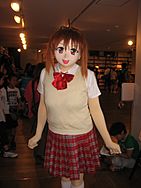Costumed performer facts for kids
A costumed performer or suit performer is someone who wears a special outfit, often covering their face, to act as a character. These characters are usually not human, like a mascot or a cartoon character. You can see them as "walk-around" characters at theme parks, as mascots for sports teams or companies, or in special shows. Some costumes completely cover the performer's face.
For example, you might see sports mascots or fantasy characters on children's television shows and in theme parks. Being a costumed performer can be very hard work. It often involves a lot of physical effort, can make you feel closed-in, and can get very hot inside the costume.
Contents
Costumed Characters in Theme Parks
Costumed performers are a big part of fun places like Walt Disney Parks and Resorts, Universal Parks & Resorts, Sesame Place, and Legoland. They are also popular at many other theme parks and fairs.
These performers help make the fantasy experience real for visitors. They let you meet and interact with your favorite fictional characters, like company or team mascots. The people inside the costumes are employees. Some costumes are just clothes and makeup, showing the performer's face. Others are full body suits that hide the performer completely, with a big head and sometimes extra clothes.
At most well-known theme parks, characters whose faces you can see (often called "face" characters) are allowed to speak. They usually follow special scripts. Characters whose faces are covered (sometimes called "fur" characters) are not allowed to speak. Instead, they communicate using pantomime, which means acting things out without words.
Sometimes, very young children can feel scared by the large size of a costume. They might also be scared by fast movements or if a character comes too close. Because of this, performers often slow down or kneel when they are near small children. This helps the child feel more comfortable and approach the character when they are ready.
For human characters from popular movies or shows, theme park workers create detailed scripts. These scripts help performers answer common questions from visitors, especially young children who might think the character is real. Performers learn these scripts by heart during their training. This helps them stay in character and respond consistently to visitors.
At busy theme parks, popular costumed performers usually have one or more assistants. These assistants are also called "handlers" or "spotters." They wear regular park uniforms and help with things like customer service, security, and managing crowds. This way, the performer doesn't have to break character to deal with these issues. If a performer needs a break, they give a special signal. Their handler will then tell visitors the character will be back soon and guide the performer to a rest area.
All theme park operators have strict rules for costumed performers. Performers are never supposed to be seen out of character by visitors. For costumes that cover the whole body, performers are never seen "with their head off." Another rule is that different performers playing the same character should not be seen together by the public. This helps keep the magic alive.
Costumed Performers in Japan
In Japan, costumed performers are called kigurumi (着ぐるみ). This name comes from the Japanese words kiru (着る), meaning "to wear," and nuigurumi (ぬいぐるみ), meaning "stuffed toy." Japan has a strong kawaii (cute) culture, so mascots are often used for promotions. These mascots often look more like chibi (small and cute) characters than Western mascots. They usually have a very large head that covers the performer's entire upper body, and their arms are placed low on the body. Other mascots look more like anime characters.
Animegao
Animegao (アニメ顔), which means "anime face," is a type of kigurumi. It is used to look like anime or cartoon characters. The performer's face is completely hidden by a special mask that looks like an anime face. The performer also wears clothes similar to what the character usually wears. Animegao costumes are used in professional stage shows and by cosplayers. These cosplayers are sometimes called "dollers," and they often make their own custom masks of different characters. While it's still a smaller part of the cosplay scene in Japan, it has become more popular in other countries like the United States, Canada, and parts of Europe since the mid-2000s.
On Television
Many TV shows feature costumed performers. For example, Big Bird from Sesame Street, Barney from Barney & Friends, and Bear from Bear in the Big Blue House are all played by costumed performers. Other shows with costumed characters include Hip Hop Harry, Yo Gabba Gabba!, and Mack & Moxy.
Older examples of shows with costumed characters include New Zoo Revue, H.R. Pufnstuf, Banana Splits, and the British series Gophers!.
The Costume Industry
Making mascots is a big business, estimated to be worth millions of dollars each year. Toronto, Canada, is a major center for this industry, with several large companies based there.
See also
 In Spanish: Kigurumi para niños
In Spanish: Kigurumi para niños



